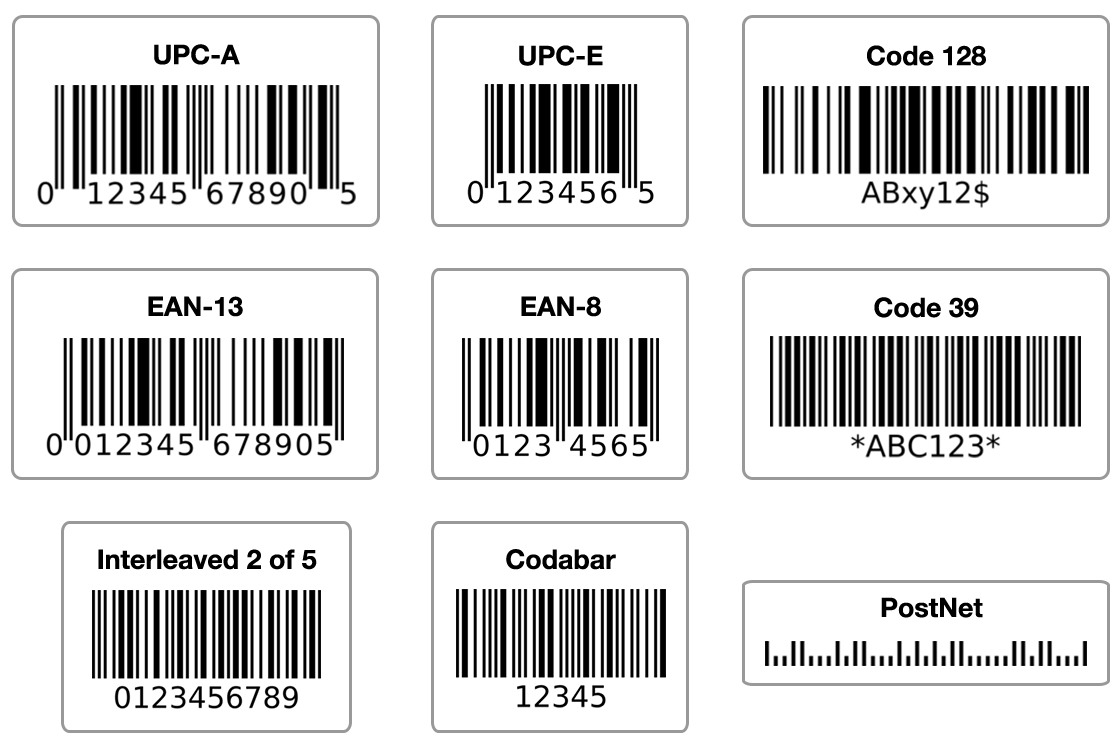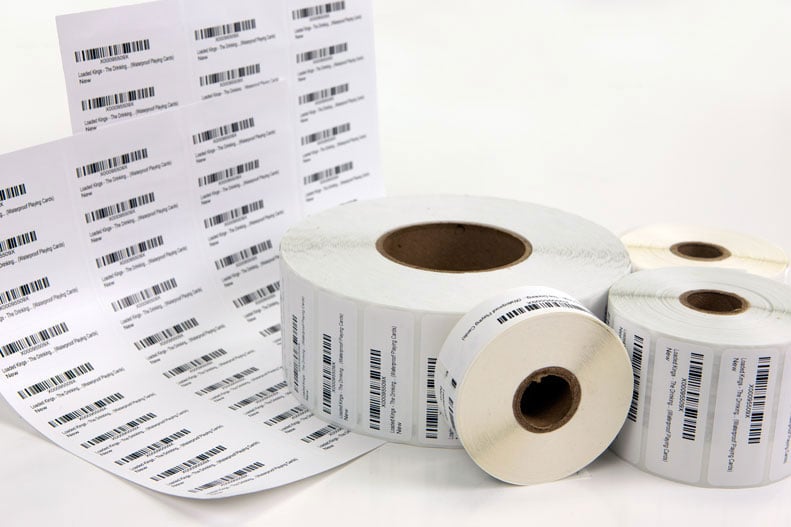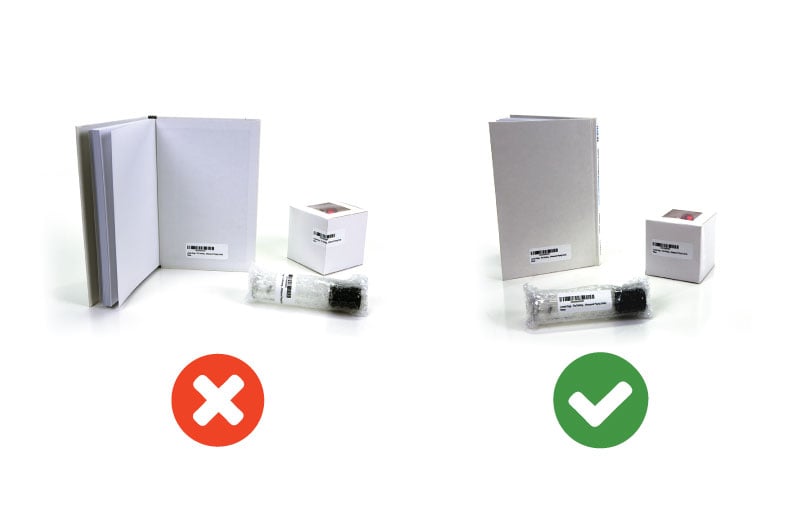Introduction to Barcodes: How to Make & Use Them in Business

Barcodes are on everything from food items to hospital wristbands. They've revolutionized business since their invention in 1949, but they've been largely underutilized by the small business community.
In an internal survey, we found that 79% of small business owners don't understand barcodes enough to implement them into their business. This is corroborated by data from major search engines – more than 20 million barcode-related searches are entered into Google every year.
At OnlineLabels.com, we believe every small business owner should have the tools they need to grow their business. In this article, we aim to provide that understanding and empower the modern small business owner to improve efficiency and take the next big step toward barcoding products and inventory.
Jump Ahead
When To Start Barcoding
When do you know if your business is big enough to need barcodes? What does it take to add them to your existing inventory or checkout system? What are the costs and tangible benefits? While every case may be different, these answers can help point you in the right direction for your business.
Why businesses use barcodes
Here are most rewarding benefits that come with barcoding your products and inventory:
Reduced Risk of Error. Manually typing a series of letters and numbers into a computer leaves your business vulnerable to inaccuracies. Every time you need to ring up a customer, track a package, or log inventory, you run the risk of hitting the wrong key on the keyboard. With manual data entry, the average person makes 1 error every 300 characters. Compare that to the accuracy rate of barcode scanners which make 1 error every 36 trillion characters. Can your business afford to take that risk?
Time Savings. Data entry is a slow process. Think of the time it takes for your brain to do something versus the speed of your computer. While in small batches the time difference may be negligible, accumulated over hours or even pay-periods, that time will add up and could be put to better use.
This can also be of utmost importance to your customers. Hand-keying products at checkout costs them time as well. Is their time worth the investment?
Lower Operational Costs. The popularity of barcodes has generally lowered the cost of the required equipment. Thus, a one-time upfront cost becomes less expensive than paying staff to execute the same tasks week after week.
You may also see this benefit with regards to your overhead. More accurate data can help you reevaluate your expenses. If you're paying for warehouse space, for example, overestimating your inventory could be costing your business unnecessary money.
Less Expenses Overall. More accurate data can help you reevaluate your expenses. If you're paying for warehouse space, for example, overestimating your inventory could be costing your business unnecessary money.
Ease of Updating Pricing. Updating product pricing can be a time and labor-intensive process if your items have price tags affixed to them. Instead, display the price on the product's shelving or as signage and use barcodes on the actual products.
This method requires much less work when prices change. Instead of changing out each individual price tag, you'd make the change once to the shelf signage and once to the barcode database.
How to decide if your small business is ready for barcodes
Barcodes are completely optional unless you're selling in a retail market (i.e. "big box stores" like WalMart and Target). For those selling on their own website or to small retailers, you might consider implementing a barcode system if:
- You run a product-based business
- You manage a lot of inventory
- You need more accurate inventory counts
- You have multiple retail or storage locations
- You need to track moving pieces
- You work with other vendors
- You want to prepare for growth
- You're not the only employee
- You want to speed up customer checkout times
- You want to appear more professional
What it takes to implement barcodes
Barcodes can be relatively painless and affordable to implement. You'll need:
Naming Convention. Also known as SKUs, product codes, or item numbers, these codes should describe each of your products in a condensed version of letters and numbers. Jump to instructions on setting up a naming convention.
Initial time investment: 1-3 hours | Rough cost: $0
Barcode Generator. Once you have your product names, you can begin creating your barcodes. While you can download barcode fonts, online generators can be easier. All you have to do is enter in your code and download your barcode for printing.
Use our free barcode generator tool to create single barcodes or our Barcode Guide to generate multiple at once.
Initial time investment: 1 hour | Rough cost: $0
Label Printer. If your home or office already has a working printer, you're all set – most standard inkjet and laser models can print barcodes. If you're in the market for one, evaluate your options.
Desktop printers work great for small batches whereas dedicated label printers are ideal for larger operations.
Initial time investment: 30 minutes | Rough cost: $30-$150
Barcode Labels. Barcodes come in variety of standard sizes. Depending on your printer type, you can shop barcode labels on sheets or rolls.
Initial time investment: 10 minutes | Rough cost: $10+
Barcoding Software. You need a system that will interpret your product codes and translate them back to you. While programs like Microsoft Excel might be great for cataloging, they aren't ideal for other processes like inventory management. Browse top software systems.
Initial time investment: 3-5 hours | Rough cost: $0-$4,000
Barcode Scanners. The software doesn't work without the hardware. You'll need to invest in at least one barcode scanner to read your barcodes and communicate with your program. Luckily, these can be relatively affordable.
Initial time investment: 15 minutes | Rough cost: $20+
What type of barcode you'll need

There are over a dozen types of barcodes serving different purposes and systems all over the world – some of which are more recognizable than others. Which type you need depends on how you'll be using them. Scroll to whichever category/categories are most applicable to your use.
Barcodes for global retail
If you're selling to the big box stores mentioned above, you will need one of the following: UPC barcodes or EAN barcodes. These are the two main types of barcodes used across the world for point-of-sale products. Which one you need is dependent on where in the world you're selling.
UPC barcodes (Universal Product Codes) are used by countries like the US, Canada, UK, and Australia. The UPC-A and UPC-E variations are used on most major retail products in those countries. UPC-A is the standard version, containing 12 numbers. UPC-E barcodes are condensed versions for smaller products and contain only 6 numbers.
EAN barcodes (formerly European Article Numbers, now International Article Numbers) are used in most of Europe, Asia, Africa, and Latin America. It's customary to use the EAN-13 barcode (comprised of 13 numbers) or the EAN-8 barcode (compressed version containing only 8 numbers).
Barcodes for in-house retail
For internal inventory management and small-scale point-of-sale systems, there are two main types of barcodes: Code 39 and Code 128 barcodes.
Code 39 barcodes are also known as USD-3 and Code 3 of 9 barcodes. They allow numbers, uppercase letters, spaces, and the following symbols: . $ - + % /. Unlike UPCs and EANs, there is no character limit for Code 39 barcodes, so they can be as short or long as necessary to store the required information.
Code 128 barcodes utilize a larger selection of characters compared to Code 39 barcodes. They use upper and lowercase letters, punctuation, numbers, and the following symbols: ! @ # $ % ^ & * ( ) - _ + = [ ] \ : ; " ‘ , < . > / ?.
Code 128 barcodes also maintain no character limit. It's recommended, however, to keep it under 30 characters as longer codes are more difficult for scanners to read. Our Code 128 barcode generator cuts off at 30 characters for this reason.
Barcodes for specialized uses
The remaining barcodes are equally as popular, but have very specific applications. You may encounter them throughout the supply chain or use them in your marketing.
Codabar barcodes are used predominantly in logistics-based operations like libraries, shipping companies, blood banks, and photo labs. Also known as Code 2 of 7, these barcodes use numbers, letters A-D, and the following symbols: . $ - + : /.
Other barcode types today are able to carry more information, but Codabar barcodes remain popular in these industries because they are easily printable. Anything from dot-matrix printers to typewriters can create Codabar barcodes.
Interleaved 2 of 5 barcodes (or ITF barcodes) are comprised of numbers only and must include an even number of digits. Each set of digits combines to create a piece of the visual barcode. These barcodes can often be seen on corrugated boxes containing packaged products.
Postnet (Postal Numeric Encoding Technique) barcodes may not sound familiar by name, but they have a distinct visual appearance that's instantly recognizable. Postnet barcodes are the long barcoded strips that come printed on mail delivered through the United States Postal Service. The series of different sized bars are used to encode ZIP code information for postal service automatic mail sorters.
QR (Quick Response) codes are different from the other barcodes included in this list in that they're 2-dimensional. While the barcodes discussed up to this point have all been horizontal in nature only, QR codes are squares – the data is stored both horizontally and vertically.
This means they can hold substantially more data. Another difference between QR codes and traditional barcodes is their use as a customer-facing tool. Brands have been using QR codes as another way to give customers information. They can contain unique content such as contact information, text, and web addresses.
How to Create Barcodes
Many barcodes can be created by individuals for use in personal point-of-sale systems. The content below only pertains to those types of barcodes, the most popular of which are Code 39 and Code 128. These "personal-use barcodes" will point solely to your personal database and thus won't pull up your product information on another system.
Other barcodes, like UPCs and EANs, are distributed by the organization GS1. Barcodes in the GS1 database can be scanned and recognized by point-of-sale systems anywhere in the world. Jump down to learn more about GS1 and UPCs/EANs.
Creating the code for your barcode

Before you can create the graphic part of the barcode, you must first come up with the codes within them. These should identify each of your products using a string of letters, and possibly numbers or other characters.
Expert tip: Figure out which type of barcode you're using before getting started. Different types of barcodes accept different characters which could alter or invalidate your naming convention. Jump back to see which characters your barcode type uses.
When formulating your naming convention, here are a few things to keep in mind:
Think about what pieces of information are important in telling your products apart. This could include size, shape, material, color, type/category/department, vendor/manufacturer, warranty, quantity, etc. Be sure to consider the future of your product line in this stage.
You don't want to pick something too small that your business will quickly outgrow. For example, just because you're only selling one color now doesn't mean you shouldn't include the color in your product code, you may have more colors down the line.
Create a standard formula. Each code should follow the same format – size first, then shape, then color, for example. Once you become familiar with the format, it will be easy to tell your products apart just by looking at the codes. More importantly, this is critical for scaling your naming convention as your business and product offerings grow.
Avoid letters and numbers that can be easily misread. This isn't exclusive to handwritten information – it applies to printed content as well. Some of the most commonly confused letters/numbers include: zero and capital O; one, capital I, and lowercase L; Z and two; and T and 7.
Abbreviate when you can. Instead of spelling out "small," simply use the letter "s." This will keep your product codes short.
Document it. Once you've created a system, you'll want to keep a key for creating new codes down the line. You should also start a running list of all the product codes and their associations.
Creating the barcode graphic
Once you have your barcode's codes, it's time to create the graphic. If you only need to make one barcode, try our free barcode generator. Choose the barcode type that best suits your needs and enter in your information. Adjust the output settings so you receive the barcode you're looking for.
The generator will produce a .png image file you can use with Maestro Label Designer or other design applications.
If you're interested in creating a series of barcodes, you can create a data list with your barcode combinations and use Maestro Label Designer to generate multiple barcodes using mail merge.
Using Your Barcodes
Once you have your .png barcode graphic(s), you can either incorporate them into your packaging or print the barcodes separately and affix them with a label. If you're using Maestro Label Designer, learn how to upload the barcode graphic so you can add it to your design. If you're printing just the barcodes, find out how to setup multiple designs on one sheet or print only a few labels at a time.
Whichever method you choose, keep the following design rules and tips in mind:
Choose colors with high enough contrast. You want the background to reflect light and the bars not to – that's why white backgrounds with black text work so well. However, you can utilize other label and ink colors (just stay away from transparent label materials!).
Size matters. Certain barcodes have minimum and maximum size limits. UPC-A barcodes, for example, only work between 80% and 200% their size. Print and scan your barcode on regular paper or a test label to ensure scannability.
Make sure you're using a high-resolution image. Blurry or low-resolution images are harder for the scanner to read.
Employ color-coding. Color-coding your labels can help with organization.
Don't print to the edge of your label. Scanners may have difficulty reading barcodes that print too close to the edge.
How to print your barcode labels

Much like standard printing, you simply need to load the label sheets (or rolls) into your printer and hit print from your desired program. Try our white label materials for best results. Several of our white labels are even waterproof, if your barcodes may come into contact with liquid or moisture.
- Laser or Inkjet: Standard White Matte
- Laser or Inkjet: Removable White Matte
- Laser or Inkjet: Aggressive White Matte
- Laser or Inkjet: 100% Recycled White
- Inkjet Only: White Gloss Inkjet
- Laser Only: White Gloss Laser
- Inkjet Only: Weatherproof Matte Inkjet (waterproof)
- Laser Only: Weatherproof Polyester Laser (waterproof)
- Inkjet Only: Weatherproof Gloss Inkjet (waterproof)
- Laser Only: Blockout for Laser
- Direct Thermal Only: Standard White
- Thermal Transfer Only: Standard White
- Direct Thermal Only: Removable
- Thermal Transfer Only: Removable
- Direct Thermal Only: Weatherproof
- Thermal Transfer Only: Weatherproof
Don't want to print the barcodes yourself? Order them printed – our printed barcode tool simplifies the process. Within days of placing your order, sheets of printed barcodes will arrive at your door.
How to apply barcode labels to your products

Your barcodes should be placed in a clear, consistent, and conspicuous spot. Before you apply them, read these tips:
- Place at least 8mm from a seam or packaging fold. Barcode scanners can't read the codes around corners.
- Find a smooth or consistently curved surface for application. Inconsistently curved surfaces will give the scanner a hard time.
- Follow the direction of the barcode. Certain scanners work best with particular orientations.
Common Barcoding Questions
Get answers to the internet's most frequently asked questions about barcodes.
What is a barcode?
Barcodes are used throughout the supply chain and across various industries. They are a visual representation of data. They are most commonly displayed as a set of parallel lines, sometimes set above a series of numbers, letters, and/or characters.
Machines decipher these visual guides and use them to complete tasks, like tracking or cataloging items.
Are barcodes unique?
UPC, EAN, and ITF-14 barcodes are unique to specific products. Because they're created as part of GS1's universal database, they pull the same result every time.
Without a database association, most of the other barcode types aren't unique. This includes Code 39, Code 128, and ITF barcode types. They can be created by different people to identify various products.
What is GS1?
GS1 is a not-for-profit organization that develops and maintains global standards for business communication. When it comes to barcoding, they assign each company a unique identification number. That number is then used as the prefix for all of the subsequent barcodes.
The remaining numbers included on barcodes are used to identify the individual products. The full code is then logged into GS1's system to be accessed by anyone.
How do you get a UPC?
UPC and EAN barcodes can only be created by GS1 and the process of purchasing one can be extremely costly. You have to pay for your unique company prefix (an annual expense) and the number of barcodes you want.
This is typically a barrier to entry for many small businesses – small business owners usually opt to use Code 39 or Code 128 barcodes instead, unless they're on the verge of retail distribution (where it's required).
While you can purchase directly from GS1, there are reputable UPC/EAN resellers out there who can make the process less costly. They mostly sell codes that were purchased by someone else and not used.
If you're interested in buying unused UPC or EAN barcodes, we recommend Speedy Barcodes.
Are barcodes and UPC codes the same?
UPCs are barcodes but barcodes are not necessarily UPCs. The scannable barcode lines are simply a machine-readable representation of the UPC data.
Are barcodes a legal requirement?
Barcodes are not required by any governmental body, but they're likely a qualification by vendors to sell in a retail environment. Products in shopping giants like Walmart and Target are all barcoded. Amazon also uses barcodes in their ecommerce operation.
Can barcodes be different colors or designed?

There's a decent amount of leeway with barcode design. As long as your combination includes colors with high enough contrast, it should be scannable. Try the original white background with black, blue, or green text. Or switch up the background color instead – red or yellow are alternates. Low-contrast combinations to avoid include red on green, black on brown, or yellow on white.
As for the design, there's even more room for creativity. Only a small section of the barcode is actually needed for scanning. This means you can create fun shapes or interrupt the lines with other design elements. Check out some creative barcode designs.
Can barcodes have letters?
Certain barcode types can utilize letters, like Code 39 barcodes. However, the most standardized options, like UPC and EAN, are strictly numeric.
How do I read a barcode?
UPC and EAN barcodes follow a specific formula, but barcodes not regulated by GS1 can be made by anyone using their own key. To read UPC or EAN barcodes, look at the first 6-10 digits to identify the company and the second set of digits to identify the individual product.
Are ITF and ITF-14 barcodes the same?
No. ITF-14 barcodes are regulated by GS1, the same way UPC and EAN barcodes are. Standard ITF barcodes are not regulated or cataloged in a database, allowing you to create your own for internal/small-scale use.
Barcoding is a big step, but it doesn't have to be a difficult one. We hope these FAQs and their answers help you feel confident as begin to create, print, and utilize your own barcodes. Have questions about your unique situation? Our customer service team is happy to help. Give us a call at 1-888-575-2235.
Download the ebook

